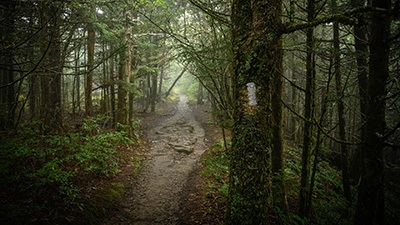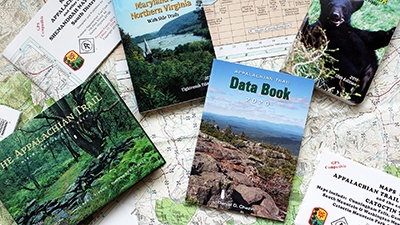ATC News
Major Barrier to Atlantic Salmon Passage in the West Branch Removed
November 20, 2023
Partners complete historic effort to restore aquatic connectivity near the Appalachian Trail in Maine
PISCATAQUIS COUNTY, Maine – The Appalachian Trail Conservancy (ATC), in collaboration with longtime conservation partner the Appalachian Mountain Club (AMC), celebrated the removal of one of the final remaining fish passage barriers on the West Branch of the Pleasant River, allowing species like the federally endangered Atlantic salmon and brook trout to swim freely upstream to spawn once again.
 The ATC’s Marian Orlousky looks out from inside the 90-foot culvert that was removed in the summer of 2023 to improve aquatic connectivity on the Henderson Brook near the A.T. Photo by Horizonline Pictures.
The ATC’s Marian Orlousky looks out from inside the 90-foot culvert that was removed in the summer of 2023 to improve aquatic connectivity on the Henderson Brook near the A.T. Photo by Horizonline Pictures.
Maine is home to the only remaining populations of wild Atlantic salmon in the United States. Identified as a priority tributary of the West Branch for Atlantic salmon recovery, the exceptional cold waters of the 3.9-mile Henderson Brook were already being utilized by Atlantic salmon in the lower portion, according to research conducted by the U.S. Fish and Wildlife Service.
This multi-year effort, led by the ATC and AMC in conjunction with local, state, and national partners, successfully removed a 90-foot-long galvanized steel culvert under the Katahdin Iron Works Road next to the Appalachian National Scenic Trail, which opened 88% or 3.4 miles of Henderson Brook that had been completely obstructed to fish rearing. The partners completed construction of a new clear-span bridge, restored the Henderson’s natural aquatic habitat beneath the bridge, and reopened the road in October 2023.
“Conserving the Appalachian Trail means more than maintaining the footpath and preserving views — it also means protecting the plants and animals that depend on Trail environments. By removing road obstructions and restoring the stream environments beneath them, Atlantic salmon will once again have access to valuable rearing waters that have been blocked for decades,” said the ATC’s Interim Vice President of Conservation and Policy Marian Orlousky. “The vision is that one day, because of this project and others like it, the A.T. corridor will again support a thriving population of Atlantic salmon.”

The restore streambed and new Katahdin Ironworks Road bridge over the Henderson Brook. Photo by Leah Beck.
“The Appalachian Mountain Club’s Maine Woods Initiative property has for 20 years worked to conserve one of the most important forested regions of the eastern United States, the 100-Mile Wilderness,” said Steve Tatko, AMC’s Vice President of Land, Research, and Trails. “AMC’s 114,000-acre ownership encompasses the headwaters of the globally significant West Branch of the Pleasant River watershed for sea-run fish and native Eastern Brook Trout. AMC has been thrilled to work in partnership with federal, state, and NGO partners to remove barriers to fish passage on our land to restore access to 126 miles of spawning habitat for Atlantic Salmon and Native Brook Trout. Henderson marks a major milestone in the restoration of the West Branch of the Pleasant River for sea-run fish, and AMC is thankful for the partnership that made it possible. We look forward to continuing these watershed-scale restoration efforts.”
This significant restoration effort was made possible thanks to a grant from the National Oceanic and Atmospheric Administration in partnership with the Atlantic Salmon Federation of Maine, funding from Bass Pro Shops and Cabela’s Outdoor Fund, the U.S. Fish and Wildlife Service’s National Fish Passage Program and Eastern Brook Trout Joint Venture, Michele and Dan Coleman (trail names “Loon” and “Griswold”), KBF Canada, National Park Trust, Davis Conservation Fund, National Park Service, The Volgenau Foundation, as well as many generous donations from ATC members and supporters.
To learn more about the ATC’s work to protect, manage, and advocate for the Appalachian National Scenic Trail and the lands and waters surrounding it, visit www.appalachiantrail.org/our-work.
About the Appalachian Trail Conservancy
The ATC was founded in 1925 by volunteers and federal officials working to build a continuous footpath along the Appalachian Mountains. A unit of the National Park System, the Appalachian National Scenic Trail ranges from Maine to Georgia and is 2,198.4 miles in length. It is the longest hiking-only footpath in the world. The mission of the ATC is to protect, manage, and advocate for the A.T. and its protected corridor of over 300,000 acres. For more information, please visit www.appalachiantrail.org.
Contact: Ann Simonelli, 304.885.0482, asimonelli@appalachiantrail.org
Discover More

Stay Informed
Latest News
Read the latest news and updates about the Appalachian Trail and our work to protect it.

Partners in Conservation
Landscape Conservation
The Appalachian Trail landscape conservation requires many partners to connect the wild, scenic and cultural wonders of the A.T. and its surrounding landscape.

OUR WORK
Science & Stewardship
Appalachian Trail management encompasses the on-the-ground stewardship performed by volunteers and agency partners to maintain the Trail, its structures, and its natural and cultural resources.





